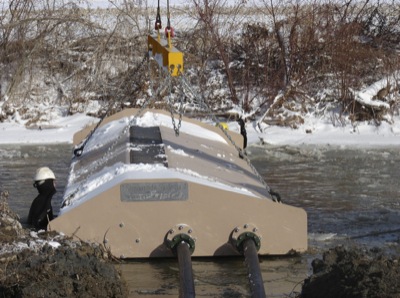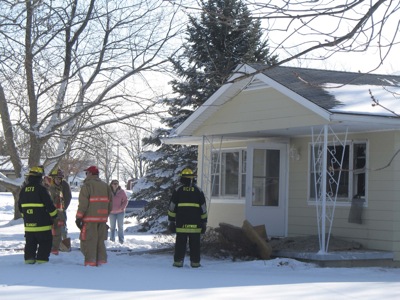Thursday, January 13th, 2011
Collector added for lake cleanup
By Nancy Allen

Submitted Photo
Employees from Streamside Systems, Findlay, install a sediment collector in Barnes Creek in Auglaize County on Wednesday afternoon. It is located behind the St. Marys Township house. The unit is designed to capture sediment and nutrients before they enter Grand Lake.
GRAND LAKE - A third sediment collector was installed Wednesday afternoon in Barnes Creek behind the St. Marys Township house, another piece of the puzzle toward restoring water quality in Grand Lake.
Two others, one in Big Chickasaw Creek and another in Beaver Creek near Montezuma, were installed last year.
A crane lifted the 8,500 pound, 30-foot-long steel unit into the air and placed it in the creek. The units are expected to catch mostly sand, which will be pumped into a geotextile bag and analyzed.
Workers had to cut through four inches of ice and push big chunks aside before installing it.
Brian Miller, interim manager at Grand Lake St. Marys State Park, said installation will be done by the end of the week.
"Today they will dig a wet well and install the pump and then they have to set the control panel," Miller said this morning.
Miller is a member of the Lake Restoration Commission, a volunteer coalition of individuals from local government and private groups formed a year ago to address the toxic blue-green algae blooms that nearly shut down the 13,500-acre lake last summer. The LRC raised money to pay for about $98,000 of the cost of the collector. Another $80,000 came from an Ohio EPA 319 grant. The LRC also paid a portion of the cost of the other two collectors.
Streamside Systems, Findlay, constructed and installed the device.
A pump attached to each collector carries captured sediment into geotextile tubes, giant bags that hold the solids and allow the water to go back into the creek. Miller said the geotextile tubes will be used at collector sites until officials find out how much material the units are capturing. More permanent containment structures may be built nearby, he said.
The collectors automatically turn on when flow increases following a rain or melt event, said LRC member Jared Ebbing. Last year there weren't enough rain events to measure the collectors' sediment capturing ability, he said. Spring rains this year should show the units' capabilities.
"Unfortunately, since we installed them there hasn't been a huge amount of rainfall to truly test them," he said. "It is our task over the next two months to work real hard to make sure all three are operational."
Miller said eventually local officials want to test putting a floculent in one of the creeks. The chemical would cause nutrients (phosphorous and nitrogen) and sediment in the water to bind so more can be captured in the collector.
Blue-green algae is fed by excess nutrients, especially phosphorous. Most excess nutrients in the Grand Lake Watershed run off farmland, which comprises more than 80 percent of the acreage in the drainage area.
The LRC also has raised money to pay for two giant aerators that were installed last year at Southmoor Shores and Park Grand Resort. Those units were removed in the fall and will be returned in the spring. The units infuse oxygen into the lake's sediment, allowing beneficial organisms to grow, eat the organic material and reduce the sediment layer.





